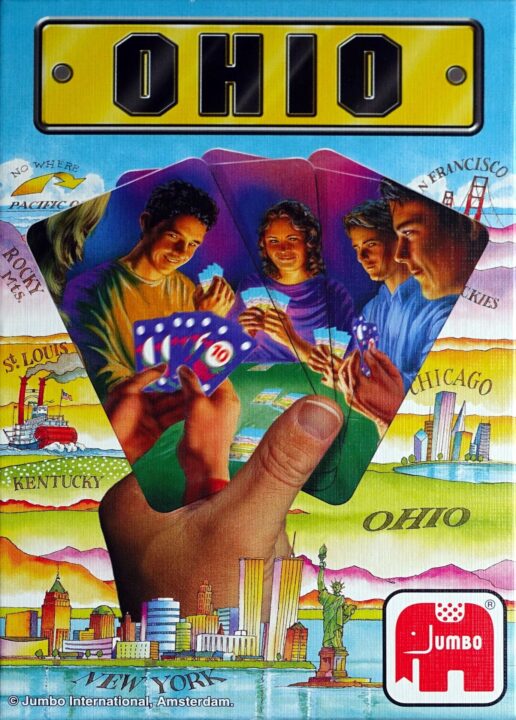If you’ve ever wondered how much chaos a group of friends can cause with just a handful of cards and very little shame, you’re in the right place. This is my review of Ohio, the game that had us plotting, giggling, and occasionally blaming Steve for everything that went wrong. If you want to know if this game is fair, fun, and actually worth your time (and money), stick around—because I’ve played Ohio enough times to develop strong opinions and a mild dislike for dice rolls.
How It Plays
Setting up
Start by putting the Ohio board in the middle of the table. Each player grabs their set of colored tokens and a secret bluff card. Shuffle the action deck and deal three cards to each person. Put the rest in a draw pile. I usually knock over my drink at this stage, but that’s optional.
Gameplay
Turns go clockwise. On your turn, play an action card: maybe claim land, block someone, or swap cards (if you’re feeling risky). You can bluff about your plan—this is Ohio, after all. Players can call your bluff, which usually ends in laughter, pointing, and maybe a new grudge. Keep an eye on your tokens, because area control is everything.
Winning the game
When the action deck runs out, count up who controls the most key spots on the board. If you have the most, you win and get serious bragging rights until the next game. If not, you start plotting your comeback speech. It’s simple, but trust me, nobody is happy until they win (especially me).
Want to know more? Read our extensive strategy guide for Ohio.
Is Ohio Fair For Everyone? Game Balance and Board Game Justice
I’ve played my fair share of unfair games. The kind where one person bulldozes everyone else, and you’re just there for the ride. Well, friends, after convincing my group to play Ohio last Friday night (with only a little bribery in the form of nachos), I can report back. Let’s talk about balance and fairness in Ohio—because no one wants to show up to game night and get steamrolled before they even finish their first snack.
In Ohio, every player starts with the same resources and general goals. I liked that. You don’t get weird advantages for just picking the red meeple or something. And there are choices—lots of them. I love choices! The game always throws a couple of curveballs, but never a total game-breaker. No wild card that lets Aunt Maureen win out of nowhere, which she somehow manages anyway. But I wouldn’t say it’s perfect. Ohio does have a bit of luck with how certain cards come out. If someone draws three good cards in a row, they shoot ahead. But mostly, skill and cunning matter. My one buddy, who wins everything, still won… but at least it felt close!
So, overall, Ohio gets a solid handshake from me on balance. It’s not flawless, but you won’t feel cheated by the game itself. Next up, let’s talk about the real spicy bit—how Ohio gets players actually talking, bluffing, and plotting like it’s Sunday lunch at grandma’s!
Player Interaction and Engagement in Ohio: Outwitting Your Friends
Let’s talk about the real spice in Ohio: player interaction. This isn’t one of those games where you sit quietly moving pieces, sipping lukewarm cola, and wondering if your opponent noticed you forgot their birthday. Nope. Ohio forces you to engage. Every move you make could mess up someone else’s plans, and trust me, my friends made sure I felt the pain every round.
You get to bluff, plot, and occasionally throw shade—all in the name of sweet, sweet victory. One round, my buddy tried to trade me a ‘killer’ cornfield, but I saw through it. Another time, two friends teamed up to block my main supply route, and I’m still holding a grudge. The game lets you scheme, form alliances, and break them as fast as you can say ‘double-cross.’ There’s a little social drama, a lot of laughter, and plenty of ways to outsmart—or totally misjudge—each other.
Honestly, Ohio is at its best when everyone is chatting and plotting out loud. The table talk is half the game, and silent players miss out on the fun (and probably lose). Even shy players get drawn in because you have to react to what everyone else is doing, unless you want to end up with cows instead of cash.
So, if you’ve ever wanted to see your friends’ true colors, this is your chance. Stay tuned, because next, I’ll tell you if Ohio has legs, or just a one-trick pony, in the replay value and variety section!
How Many Times Can You Shout “Ohio!” Before It Gets Old?
Let’s talk about replay value, because nobody wants a board game that turns into a coaster after one round. Ohio, to its credit, keeps things fresh a lot longer than that carton of milk I forgot in my fridge last summer. Each time I play Ohio with my group, something new happens—sometimes it’s a sneaky showdown, sometimes it’s pure chaos, and every once in a while, it’s just my friend Greg trying to convince us that his bad luck is actually a strategy.
The thing that keeps pulling me back to Ohio is the way the game doesn’t stick you in a rut. You can try out different tactics each game—do you go for bold moves, or do you play it safe and annoy everyone by being unpredictable? There’s enough variety in the set up and in the decisions you make, so you don’t just repeat the same old song and dance. Even better, with different player counts, the game feels a bit different. With four players, it’s wild and crowded. With two, it’s a tense, back-and-forth knife fight. Not literally, thankfully, because nobody wants to explain board game injuries to their family.
I still found a few cracks though. If you play, say, ten times in a row, the shine starts to fade a bit. You’ll see some of the same situations pop up, and you might get a whiff of deja vu. But for casual game nights, Ohio has more staying power than my old Tamagotchi (RIP, pixel pal).
Next, I’ll stumble through the rulebook and see how easy this thing is to actually learn—so grab your reading glasses and stay tuned!
Mastering Ohio: Are the Rules as Clear as a Bell?
Let’s talk about the rules in Ohio. When my friends and I first cracked open the box, we were all hoping for an easy start. No one had the energy to decode a 40-page manual after a long week. Imagine our delight when we found the rulebook for Ohio only took about five minutes to read. That’s only two minutes longer than it takes my buddy Steve to find his misplaced dice.
The rules are laid out in a step-by-step way. Each round, you know exactly what to do. There’s even a great player aid that sits right by your meeples, like a loyal game dog helping you not mess up. I only had one moment where I had to squint at the wording and ask, “Wait, does that mean I can or can’t use my extra token?” Thankfully, the FAQ online cleared that up fast.
If you’ve played any modern board games, you’ll pick up Ohio’s mechanics within one round. Even my friend who zones out halfway through instructions managed to win the second game. (Still not sure if it was skill or pure luck, but let’s give him credit.)
In short, Ohio’s learning curve is smooth and friendly, perfect for new players and veterans. As long as you don’t read the rules upside-down, you’ll be just fine.
If you want a game that respects your brain and your patience, I recommend Ohio. It won’t twist your mind into a pretzel—unless you spill snacks on the rules.
Conclusion
Alright folks, that wraps up my Ohio adventure! After wrangling my friends for far too many rounds (one of them still holds a grudge over a sneaky card swap), I can say Ohio is a fun, easy-to-learn game that finds a solid spot on my shelf. Sure, there’s a pinch of luck tucked in there—just enough to keep things spicy, not enough to make you want to flip the table (unless your name is Dave). The player interaction makes each round feel different, and the rules won’t leave you in a cold sweat. If you want a game with plenty of plotting and good replay value, but don’t want to spend your whole night reading rules, give Ohio a shot. It’s not perfect, but it sure is a good time. That’s it for this review—now go grab some snacks and get playing!


